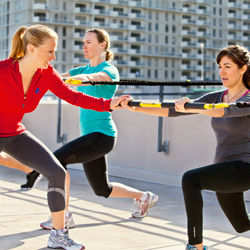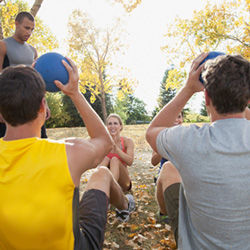
Perhaps you’ve been offering small-group training (SGT), also known as semiprivate training, for a while. Or maybe you’ve been tossing the idea around but haven’t yet ventured out of your one-on-one training realm. Either way, this article is sure to spark some new ideas for you that could lead to more clients and more revenue.
Small-group training sort of fell into my lap a few years ago. I had been offering one-on-one training and teaching group fitness classes for years but had not given SGT a try. When a husband and wife team approached me and wanted to train together, it was a perfect opportunity to expand my services and ease into SGT with the smallest number of participants that could count as a group.
Small-group Training…or Group Fitness Class?
While many guidelines for SGT allow for up to 12 participants, I find that groups made up of two to five people work best. And if you’re in a smaller, more rural market area like me, 12 participants may be a decent group fitness class size for you, so thinking of having a SGT group that large may not make sense to you.
Henry Halse, C.S.C.S., of New York City, agrees with having smaller semi-private groups—especially if there is just one trainer. “Four to five [participants] is ideal if you only have one coach. It’s safe to assume that two or three people will need help with their form on an exercise. If you go over four or five people, you might not be able to help someone with their exercise, which negates the benefit of small-group training.”
Heather Glenn, an ACE Certified Personal Trainer and Behavior Change Specialist, feels that eight participants is the maximum any small group should have with one trainer. “This gives you the ability to do team and partner work but is still small enough to give cues and individual coaching, as well as correct form.”
Becoming comfortable with SGT can take some practice, especially if you’re only experienced with one-on-one training. “I think any fit pro can be successful at small-group training with practice and proper training,” says Glenn. “That said, not all trainers enjoy small-group training.”
If, for instance, you really appreciate being able to nurture a closer relationship with your clients and the opportunity to discuss other issues specific to their circumstances, such as food and stress, then SGT may present some challenges.
“There are some great benefits to working one-on-one with clients,” Glenn points out. “You can customize the program completely and have plenty of time and privacy to talk about the client’s specific goals. Clients do lose some of the customization and the full focus of the trainer when training in a group.”
For SGT participants who desire a bit more of your individual attention, whether it’s for questions about their workout, nutrition, stress or other lifestyle factors, there are a few options you can employ. For example, you could include one individual consult with every SGT package purchased; just make sure you work the cost of your time for that consult into the total package price. Alternatively, you could offer consults as a separate purchase.
Think “Outside” the Box
In her CERTIFIED article on SGT, Megan Senger fully outlines possible class structures. If you’re new to SGT, consider starting with a program that features defined start and end dates, lasting about six weeks. It’s also helpful when first starting out to do themed SGT, where participants all have similar goals. For example, you could offer an SGT wedding package, 5K package, yoga package or a beginner’s free-weight package.
If you work out of your clients’ homes, as I do, SGT is a possibility for you, as well. In my experience, this scenario lends itself best to several people who know each other, such as friends, family, coworkers and acquaintances. You also need a space big enough in one of the homes for your small group—or inquire about renting a studio space or a space in a community building by the hour. In these types of locations, you will most likely be using minimal equipment, so you will need to unleash your creativity to develop effective programming.
“I love being outdoors,” says Glenn. “There is so much space outside and you can use nature to keep workouts interesting. The fresh air is invigorating and good for the soul.”
And there is research to back this up. Taking your small groups outside to work out, also known as green exercise, has the potential to:
- Improve mood
- Reduce depression
- Enhance self-esteem
Exercising outdoors can also be very grounding and help your clients connect more with nature and the world around them. This can also be a much-needed break from their office work.
Despite these additional benefits, Halse prefers the gym environment for smaller groups. “Small groups work best in a gym, because the equipment allows you to get creative and push people with advanced exercises.”
Glenn has a different take on it. “I do not personally enjoy small groups in the weight room. It’s just too challenging with limited space and having to put people on different pieces of equipment at once.”
In my experience, other gym members can get irritated from your small group taking up too much space during their workout time. Of course, the feasibility of using any facility depends on factors such as the time you offer your training (and how crowded the location may be at that time), the set-up of the gym and available equipment, and whether or not it works to have a small group training in the same space as solo exercisers.
Structure It
Whether you're working with your small group at the gym, in a studio, at a client's home or outside, there are many different possible formats for the workouts. For example:
- Circuit. Set up a circuit with stations. Circuits are great for clients who don’t want to be in the spotlight when receiving individual attention, as everyone is focusing on what they need to do at their own stations.
- One at a time. If you have enough cardio equipment available, have all but one of your clients performing cardio while you do one or more strength-training exercises with one client at a time, rotating each client back to cardio after each set(s). You can have clients doing the same strength-training exercises, but individualize the amount of resistance, or individualize it further by having them do different exercises according to their own needs.
- Everyone at once. This may be the most challenging structure for trainers new to SGT, as it presents some difficulties with individualizing workouts for your small-group participants. One way to keep your SGT participants moving throughout the session with this format is to take a cue from circuit training: do timed sets instead of counting reps.
I typically rotate through these different formats over time with my small groups to keep the workouts fresh and my clients on their toes. You can also incorporate partner exercises into any of these formats.
So, do you think SGT is for you?
“Fit pros should know that small-group training is the best environment to grow as a trainer,” encourages Halse. “You get to practice techniques you learn in seminars and classes, because there’s time for individual attention. At the same time, it’s fun to bounce around to different people and learn how to deal with different personalities. [One-on-one] training simply doesn’t offer the same volume of clients and pace of learning.”
Glenn agrees. “Group training has major upsides. You can help more people in less time, earn more in less time, and keep people inspired and accountable through connection with others. It’s more affordable for people, so they can see you more often. All around, there are so many more pros than cons in my opinion.”
Further Your Knowledge
Small Group Training Workshop (0.5 CECs)
 This workshop covers the principles and application of exercise program design through an in-depth look at the ACE Integrated Fitness Training® (ACE IFT®) Model. Participants develop an understanding of how to apply the variables of exercise program design to influence desired adaptations to a small-group training program. You’ll also learn how to explain the general benefits of small-group training programs to participants, how to develop a progressively challenging exercise program based on the ACE IFT Model, and how to teach progressions and regressions of an exercise.
This workshop covers the principles and application of exercise program design through an in-depth look at the ACE Integrated Fitness Training® (ACE IFT®) Model. Participants develop an understanding of how to apply the variables of exercise program design to influence desired adaptations to a small-group training program. You’ll also learn how to explain the general benefits of small-group training programs to participants, how to develop a progressively challenging exercise program based on the ACE IFT Model, and how to teach progressions and regressions of an exercise.
Click the link above to see specific dates and locations for this live workshop.
Branch Out! Four Fun and Fresh Circuit-training Formats (article)
 While high-intensity interval training seems to get all the attention these days, circuit training has never really gone out of style. In addition to being versatile, circuits are the perfect solution when you don’t have a wide range of equipment from which to choose. This article features four fun, expert-recommended circuit workouts you can instantly apply to your training sessions or classes.
While high-intensity interval training seems to get all the attention these days, circuit training has never really gone out of style. In addition to being versatile, circuits are the perfect solution when you don’t have a wide range of equipment from which to choose. This article features four fun, expert-recommended circuit workouts you can instantly apply to your training sessions or classes.
Small Group Training: Program Design for Healthier Communities (free live webinar)
 In this video training, ACE Certified Personal Trainer and founder and owner of San Diego Premier Training Mike Deibler, M.S., C.S.C.S., explains how to put systems in place to screen clients for small-group training. He also covers how to create a periodized plan for a group of participants having different fitness levels and needs. With information about proper client intake, modifications, different motivation/leadership styles and proper planning for a variety of individual needs, this course will set you up for small-group training success.
In this video training, ACE Certified Personal Trainer and founder and owner of San Diego Premier Training Mike Deibler, M.S., C.S.C.S., explains how to put systems in place to screen clients for small-group training. He also covers how to create a periodized plan for a group of participants having different fitness levels and needs. With information about proper client intake, modifications, different motivation/leadership styles and proper planning for a variety of individual needs, this course will set you up for small-group training success.
Mark your calendars for 11 a.m., May 22, 2019, to attend this live webinar.

 by
by 

 This workshop covers the principles and application of exercise program design through an in-depth look at the ACE Integrated Fitness Training® (ACE IFT®) Model. Participants develop an understanding of how to apply the variables of exercise program design to influence desired adaptations to a small-group training program. You’ll also learn how to explain the general benefits of small-group training programs to participants, how to develop a progressively challenging exercise program based on the ACE IFT Model, and how to teach progressions and regressions of an exercise.
This workshop covers the principles and application of exercise program design through an in-depth look at the ACE Integrated Fitness Training® (ACE IFT®) Model. Participants develop an understanding of how to apply the variables of exercise program design to influence desired adaptations to a small-group training program. You’ll also learn how to explain the general benefits of small-group training programs to participants, how to develop a progressively challenging exercise program based on the ACE IFT Model, and how to teach progressions and regressions of an exercise. While high-intensity interval training seems to get all the attention these days, circuit training has never really gone out of style. In addition to being versatile, circuits are the perfect solution when you don’t have a wide range of equipment from which to choose. This article features four fun, expert-recommended circuit workouts you can instantly apply to your training sessions or classes.
While high-intensity interval training seems to get all the attention these days, circuit training has never really gone out of style. In addition to being versatile, circuits are the perfect solution when you don’t have a wide range of equipment from which to choose. This article features four fun, expert-recommended circuit workouts you can instantly apply to your training sessions or classes. In this video training, ACE Certified Personal Trainer and founder and owner of San Diego Premier Training Mike Deibler, M.S., C.S.C.S., explains how to put systems in place to screen clients for small-group training. He also covers how to create a periodized plan for a group of participants having different fitness levels and needs. With information about proper client intake, modifications, different motivation/leadership styles and proper planning for a variety of individual needs, this course will set you up for small-group training success.
In this video training, ACE Certified Personal Trainer and founder and owner of San Diego Premier Training Mike Deibler, M.S., C.S.C.S., explains how to put systems in place to screen clients for small-group training. He also covers how to create a periodized plan for a group of participants having different fitness levels and needs. With information about proper client intake, modifications, different motivation/leadership styles and proper planning for a variety of individual needs, this course will set you up for small-group training success.
